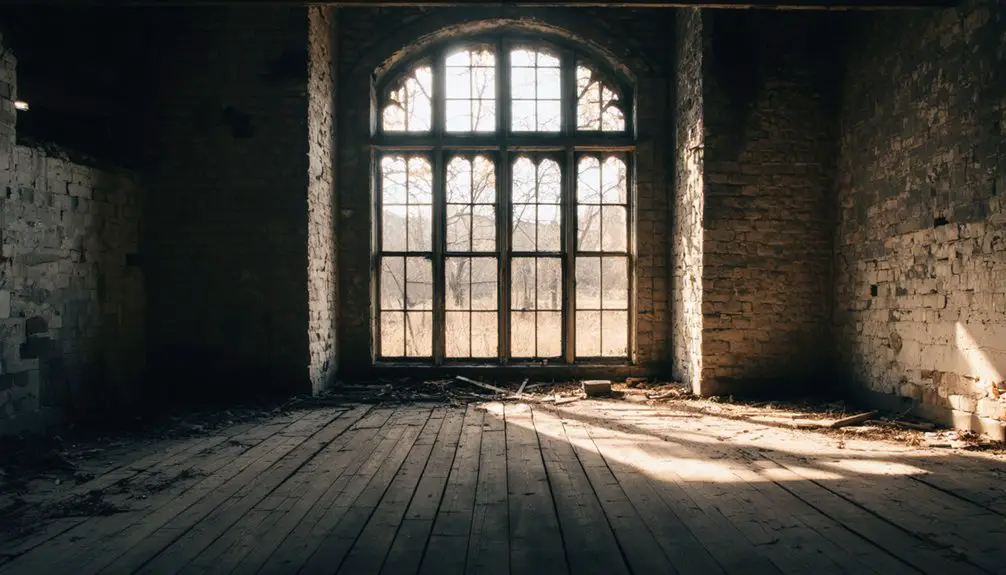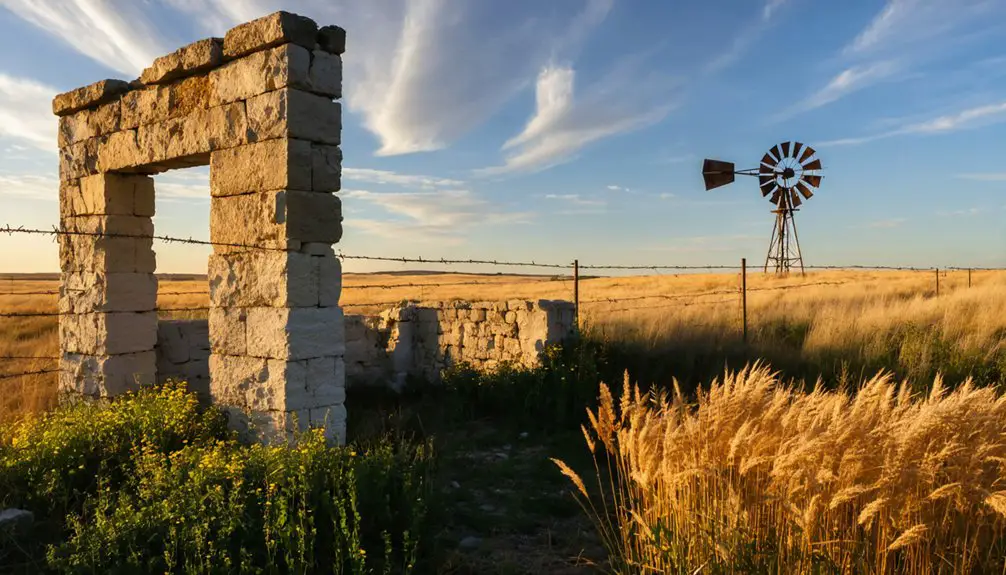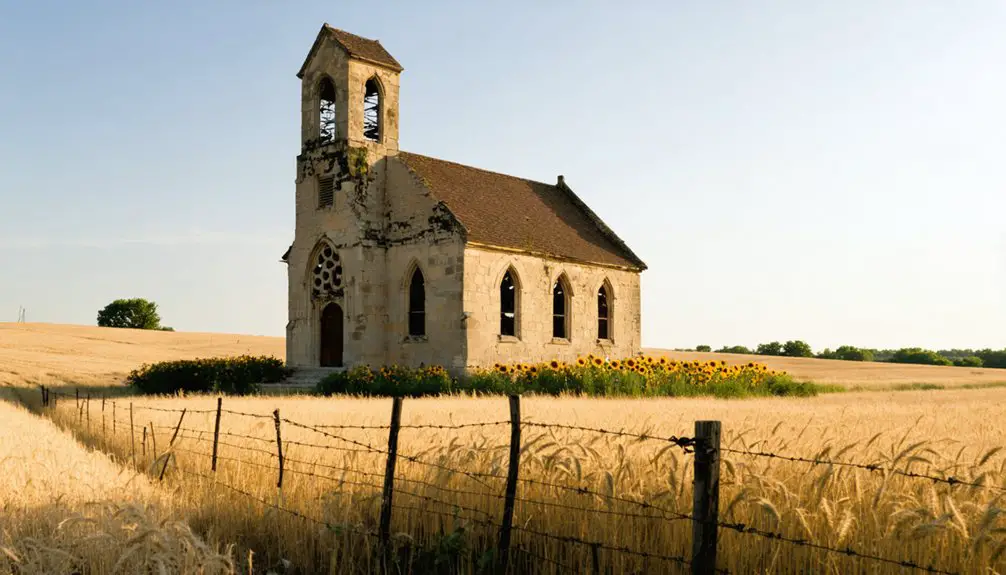You’ll find Boston’s ghost town remnants in southeastern Kansas, where ambitious settlers from Osage Mission established the community in the early 1870s. The town flourished briefly as a political hub, gaining its post office in 1871 and vying for county seat status. Intense rivalry with Elk Falls and Peru, coupled with election fraud scandals in 1872, marked its turbulent peak. When the railroad bypassed Boston for nearby Moline, the once-promising settlement’s fate was sealed, though its fascinating story of frontier politics endures.
Key Takeaways
- Boston was established in early 1870s Kansas by three young settlers from Osage Mission as an independent community.
- The town received its post office in 1871 and competed intensely with Elk Falls and Peru for county seat status.
- Political corruption and election fraud in 1872 severely damaged Boston’s aspirations for becoming the county seat.
- The establishment of railroad lines in nearby Moline diverted economic activity, leading to Boston’s eventual decline.
- Today, Boston exists only in historical records, with no physical structures remaining from the original settlement.
The Birth of a Settlement: Origins and Founding
Three young men from Osage Mission in Neosho County ventured west to establish Boston, Kansas in the early 1870s. Their founding motivations stemmed from grassroots ambitions rather than railroad or land company interests, setting Boston apart from many other Kansas settlements of that era. Much like Hunnewell’s establishment which saw its first post office open in 1880, Boston’s early development centered around postal services.
You’ll find the town’s origins deeply intertwined with the political landscape, as these pioneers strategically positioned Boston as a potential county seat amid regional power struggles. The settlement dynamics reflected broader patterns of migration within southeastern Kansas, as younger settlers moved away from mission territories to establish independent communities. The town became embroiled in county seat disputes that would eventually lead to armed conflict.
Boston gained official recognition when its post office opened on August 28, 1871, marking its emergence during a period of rapid post-Civil War expansion in Kansas.
Political Power Struggles and County Seat Wars
While Boston’s founding showed early promise, the town soon became embroiled in fierce county seat wars that would ultimately seal its fate. The intense county rivalry between Boston, Elk Falls, and Peru sparked multiple contentious elections, with each town vying for political dominance in Howard County.
- Election corruption emerged in 1872 when allegations of fraud tainted the voting process.
- Officials refused to certify the results due to suspected ballot tampering.
- Political factions engaged in heated disputes that divided the local population.
- Boston’s supporters invested heavily in infrastructure to strengthen their claim.
- The ongoing power struggles created deep rifts between neighboring communities.
The political turmoil surrounding the county seat designation would prove devastating for Boston’s future, as the town’s prosperity hinged on securing this coveted administrative status. The need for proper article disambiguation became critical as historical records of the various competing towns often caused confusion among researchers studying the county seat conflicts.
Life in Early Boston: Community and Development
Beyond the political turbulence that gripped Boston during its county seat wars, the town’s early years revealed a rich tapestry of community development.
You’d have found a diverse blend of New England Free-Staters and Ohio settlers shaping the community dynamics after the town’s founding in March 1855. The social networks that emerged reflected Protestant values and antislavery ideals, with Methodist influences particularly visible in the establishment of Bluemont Central College. Much like New Amsterdam’s early Dutch trading post, the frontier settlement emerged as a strategic economic outpost.
The settlement’s strategic location near the Kansas and Big Blue rivers fostered economic growth through supply trade and river commerce. The Kansas Pacific Railroad arrival in 1866 further strengthened the town’s economic prospects.
While the original Kaw people had departed by 1854, the new settlers quickly established homes and basic infrastructure. The New England Emigrant Aid Company’s support proved essential in developing this frontier community’s foundation.
The Decline: Factors Behind Boston’s Downfall
You’ll find that Boston’s decline was heavily influenced by political turmoil surrounding contentious county seat elections, where evidence of fraud nullified results and damaged the town’s administrative aspirations.
The establishment of the railroad two miles north in Moline dealt another significant blow, as it diverted essential economic activity and transportation routes away from Boston. The pattern echoed other Kansas towns like Empire City, where diminishing resources ultimately led to their demise. Like many ghost towns affected by economic depressions, the population steadily declined as opportunities vanished.
The loss of both political prominence and commercial dynamism led to the closure of crucial institutions, including the post office in 1879, and triggered an exodus of businesses and residents to better-connected neighboring communities.
Political Power Shifts
As Boston, Kansas vied for political prominence in the early 1870s, a series of contentious county seat elections ultimately contributed to the town’s downfall. Much like the pro-slavery leadership tensions that divided Columbia in 1855, Boston’s political landscape was fraught with conflict. The questionable practice of giving town lots to legislators had previously tainted capital city selection in Kansas.
Political alliances formed and fractured as multiple towns competed for administrative control, while concerns over electoral integrity plagued the process.
- Boston’s hopes were dashed when fraud allegations nullified the September 1872 election returns.
- Rival towns like Longton, Peru, and Elk Falls intensified their competition for political dominance.
- The persistent battles between “would-be politicians” destabilized local governance.
- Voter disenfranchisement and civic distrust grew as electoral manipulation became common.
- Like Lecompton before it, Boston’s inability to secure the county seat led to its rapid decline.
The town’s political turmoil discouraged population growth and investment, while competing interests prevented the emergence of a stable governmental center.
Economic Support Vanished
While Boston initially flourished through its resource-based economy, the town’s fortunes dramatically reversed once those economic pillars began to crumble.
The town’s economic vulnerability became apparent as its primary industries – mining and agriculture – faced depletion and declining profitability. You’ll find that poor resource management and a lack of economic diversification left Boston particularly susceptible to downturns. The town’s decline reflected a common pattern of rural decay as agricultural industrialization transformed the region’s economic landscape.
As the economic foundation eroded, you could see the ripple effects throughout the community. Supporting businesses shuttered their doors, young workers fled to urban centers, and the aging infrastructure fell into disrepair.
The town’s tax base shrank dramatically, leaving insufficient funds for essential services and maintenance. Without the means to attract new investment or industries, Boston found itself trapped in a devastating cycle of economic decline that would ultimately seal its fate.
Comparative Analysis With Other Kansas Ghost Towns

Understanding Boston’s decline becomes clearer when compared to other Kansas ghost towns of the era. When examining ghost town comparisons and demographic shifts across Kansas, you’ll find Boston’s story echoes similar patterns of decline, though each town faced unique challenges.
- Elk Falls managed to survive with a small population and tourism draw, thanks to its historic Pratt Truss Bridge.
- Irving’s fate was sealed by devastating natural disasters and tornadoes.
- Barrett started strong with mills but couldn’t overcome persistent droughts.
- Centennial City boasted 600 residents before cheaper coal elsewhere killed its economy.
- Boston’s struggles centered on political instability from county seat disputes.
While Boston lacked the environmental challenges of Irving or the industrial decline of Centennial City, its minimal infrastructure and political issues ultimately contributed to its downfall.
Historical Significance in County Formation
Boston’s pivotal role in Howard County’s formation shows you how political power struggles shaped early Kansas settlements, as the town emerged amid intense competition for the county seat designation.
You’ll find that Boston’s establishment by Osage Mission settlers represented grassroots involvement in local governance, challenging the legitimacy of other proposed administrative centers like Peru and Elk Falls.
The town’s participation in the controversial 1872 election, which was ultimately nullified due to fraud, demonstrates how deeply intertwined settlement patterns were with administrative ambitions in territorial Kansas.
Political Power Struggles
During the early 1870s, intense political rivalries erupted as Boston vied with Longton, Peru, and Elk Falls to become the new Chautauqua County seat.
You’ll find these struggles weren’t unique to Chautauqua County – they reflected broader territorial conflicts that shaped early Kansas development.
The political landscape was fraught with:
- Rampant election fraud that forced commissioners to nullify the September 1872 results
- Power grabs by would-be politicians exploiting local rivalries
- Territorial legislature manipulations through bribery and stock schemes
- Pro-slavery and anti-slavery factions battling for county control
- Frequent shifts in local leadership that destabilized governance
The contentious environment surrounding Boston’s bid for county seat status mirrored the volatile politics of Kansas Territory, where competing interests constantly reshaped political boundaries and power centers.
Pivotal Early Settlement Location
Three key factors positioned Boston as a pivotal early settlement in Chautauqua County’s formation.
First, you’ll find its strategic establishment by ambitious young settlers from Osage Mission in 1871 coincided perfectly with the county’s organizational phase, demonstrating the settlement dynamics that shaped Kansas’s frontier development.
Second, Boston’s acquisition of a post office that same year established it as an official hub for communication and commerce, attracting settlers and fostering community resilience during the region’s formative period.
Third, the town’s role as a serious contender in county seat elections reflected its significance in the area’s political landscape.
While Boston ultimately faded into history, its brief but intense period of influence exemplifies the fluid nature of frontier town development in 19th-century Kansas.
Present-Day Legacy and Historical Records

Although no physical structures remain today, the legacy of Boston, Kansas persists primarily through historical records and regional folklore.
You’ll find its story preserved in county archives, commissioner minutes, and newspapers from the 1870s, painting a picture of frontier ambition and political strife.
- Boston’s post office establishment on August 28, 1871, marked its official recognition
- Electoral disputes in 1872 led to contentious battles over county seat status
- Citizens conducted a bold raid on Elk Falls, seizing county records
- Documentation exists mainly through administrative records and local petitions
- The town’s influence shaped regional development despite its eventual dissolution
These historical records reveal how Boston’s brief existence impacted Howard County’s early governance and settlement patterns, even though the town itself faded into extinction.
Frequently Asked Questions
Were There Any Notable Crimes or Lawlessness Reported in Boston, Kansas?
Lacking lawful leads, you won’t find documented crime history or confirmed law enforcement cases in Boston, Kansas. While frontier towns often experienced lawlessness, specific reports from this settlement remain mysteriously missing.
What Was the Maximum Population Boston, Kansas Ever Reached?
You’ll find historical records don’t provide an exact peak population, but analyzing regional growth patterns and comparing nearby settlements suggests Boston likely reached between 100-300 residents at its height.
Did Any Famous Historical Figures Ever Visit Boston, Kansas?
You won’t find records of any famous visitors to Boston, Kansas. Despite its brief historical significance in local county seat disputes, available research doesn’t show any nationally recognized figures ever stopping there.
What Native American Tribes Originally Inhabited the Boston, Kansas Area?
You’ll find the Kanza (Kaw) tribe primarily inhabited this area, establishing essential settlements like Blue Earth Village. Their tribal history and cultural significance deeply influenced the region’s early development.
Were There Any Churches or Schools Established in Boston, Kansas?
You won’t find documented church history or school legacy for this location. Historical records don’t show evidence of any established churches or schools during the town’s brief existence in the 1870s.
References
- https://legendsofkansas.com/boston-kansas/
- https://www.hhhistory.com/2019/05/ghost-towns-of-kansas.html
- https://www.youtube.com/watch?v=iB5rHT14eVI
- https://www.youtube.com/watch?v=ie3zwwHm2Jg
- https://www.kcur.org/arts-life/2022-04-09/ghost-towns-are-all-around-kansas-city-if-you-know-where-to-look
- https://www.rileycountyks.gov/441/History-of-Riley-County
- https://www.legendsofamerica.com/hunnewell-kansas/
- https://www.geotab.com/ghost-towns/
- https://www.youtube.com/watch?v=OyBXD18P_j4
- https://esirc.emporia.edu/bitstream/handle/123456789/1577/McQuin Vol 8 Num 3.pdf



